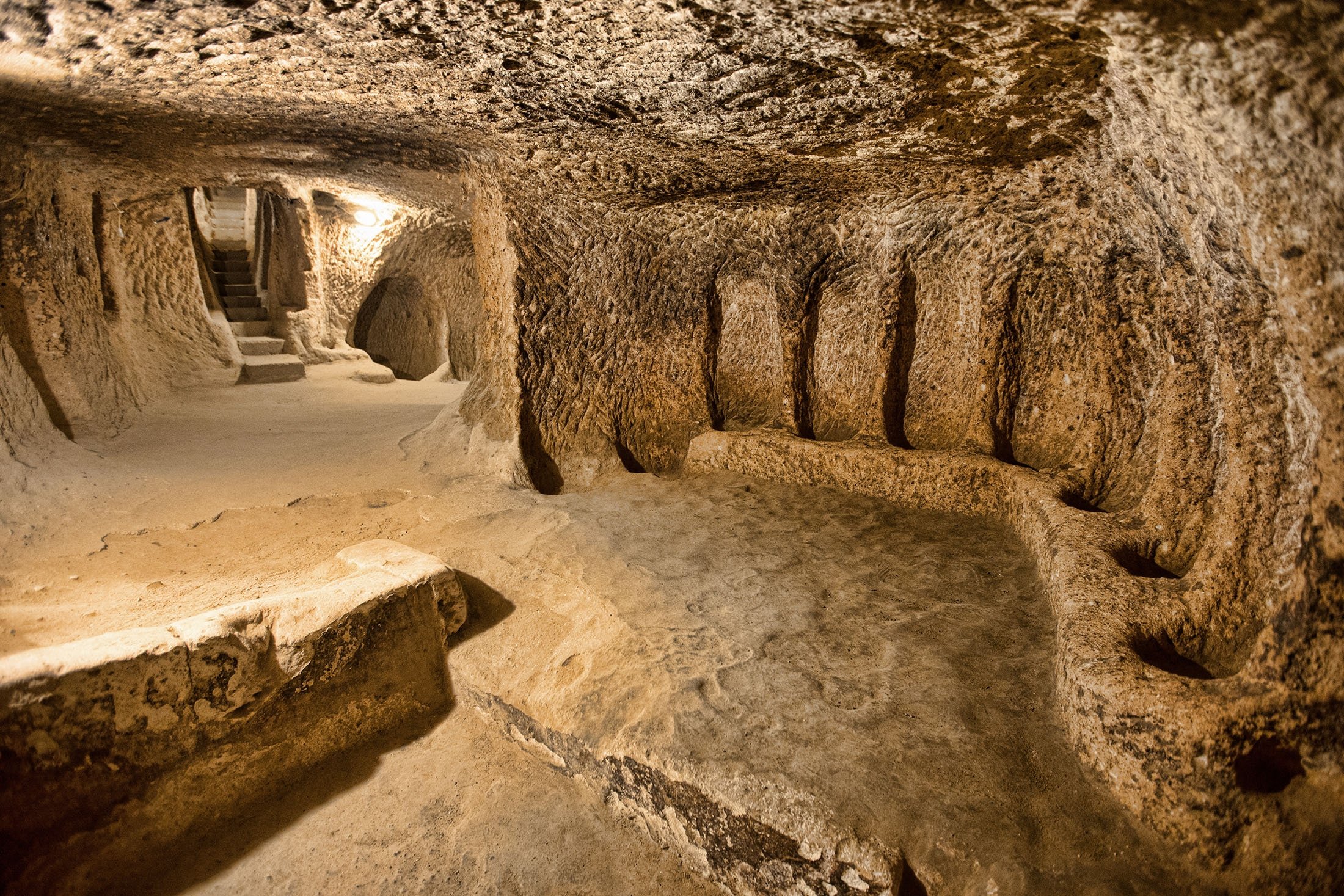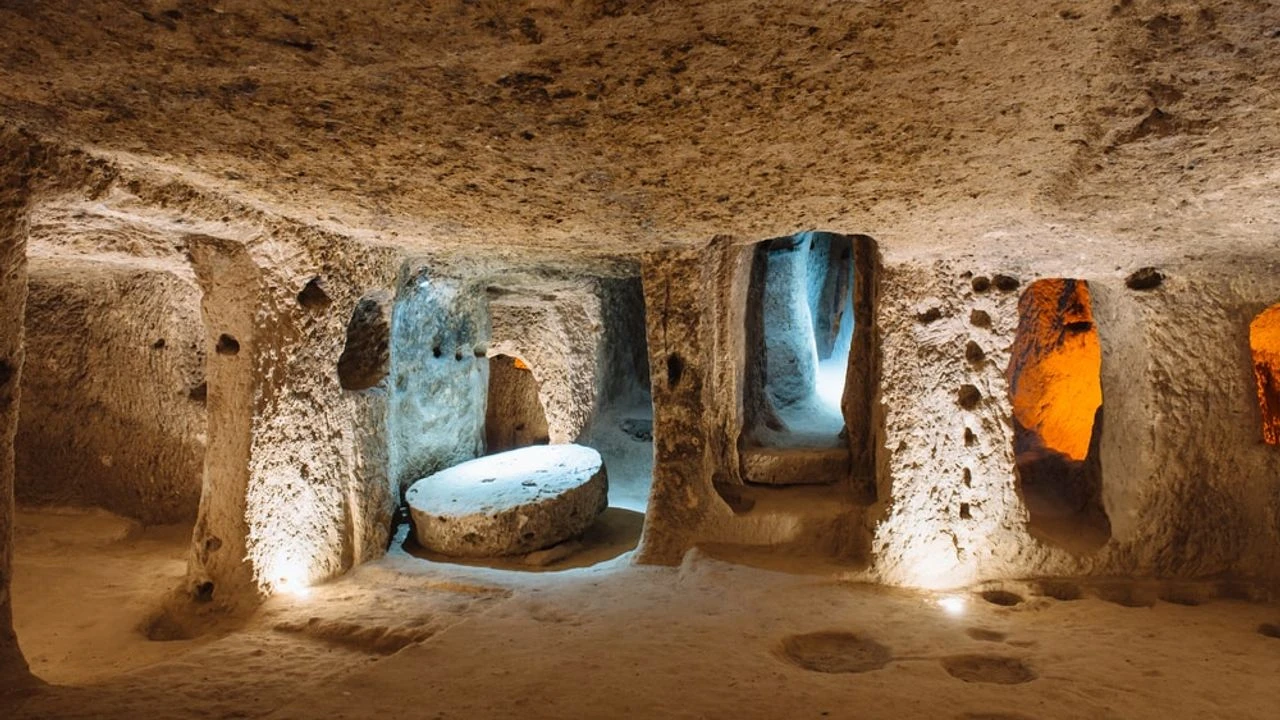Have you ever wondered how, thousands of years ago, tens of thousands of people built a life dozens of meters below the ground, at a depth equivalent to a modern apartment building? Beneath the fairy-tale surface of Cappadocia, adorned with its famous fairy chimneys, lies a completely different world: one filled with secrets, engineering marvels, and an incredible story of survival. This is a place where the stones come alive and tell tales thousands of years old.
If you want to unravel this mystery and are putting together a list ofthings to do in Derinkuyu or Kaymaklı, you've come to the right place. This guide will take you into the heart of these labyrinths not just as a tourist, but as an explorer. These massive structures, with a history stretching back to the Hittites, became a sanctuary for the first Christians fleeing Roman persecution and Arab raids. They were built not just for hiding, but for living, believing, and carrying on a culture. Fasten your seatbelts, because we're about to embark on an unforgettable journey deep into the earth!
Visit one of the underground cities: Derinkuyu or Kaymaklı

It's the classic question for every visitor to Cappadocia: with limited time, which one should I see, Derinkuyu or Kaymaklı? There's no single right answer to this question, as each offers a completely different adventure. In short, Derinkuyu makes you feel like you're in an underground metropolis with its enormous scale and depth, while Kaymaklı, with its more labyrinthine and horizontal layout, fuels your sense of discovery. One is like a vertical skyscraper descending into the earth, while the other is like a horizontal village spread over a wide area.
Derinkuyu: The Metropolis Below
Derinkuyu is like a 20-story apartment building constructed underground! With a depth reaching approximately 85 meters and a capacity once thought to house 20,000 people, it truly pushes the limits of imagination. It proudly holds the title of Cappadocia's largest and deepest underground city.
One of the most significant features that sets Derinkuyu apart is the Missionary School on its second floor. This spacious area, with its barrel-vaulted ceiling—a rarity in underground cities—proves that this was more than just a shelter. The inhabitants weren't just trying to survive; they were providing organized education to pass on their faith and culture to future generations. This school shows that Derinkuyu was not a temporary hideout, but a fully-fledged, self-sufficient ark of civilization. Furthermore, religious spaces unique to Derinkuyu, such as a confessional and a baptismal pool, reveal how developed the social and spiritual life of this community was.
Kaymaklı: The Labyrinthine Village
While not as deep as Derinkuyu, Kaymaklı spreads over a wider area with more winding corridors, giving you the feeling that you're about to discover a new room at any moment. Here, the feeling of getting lost is part of the adventure. Its structure, which more closely resembles a village settlement, offers a more intimate and exploration-based experience. The most interesting detail that makes Kaymaklı unique is the andesite stone with dozens of holes on it, found in the kitchen on the third floor. Researchers believe this stone was used to grind copper ore or for cold-forming copper. This is a rare piece of evidence showing that not only agriculture and animal husbandry but also industrial activities like mining took place underground. Additionally, the high concentration of food storage depots and wineries in Kaymaklı highlights the importance of communal living and resource management. A practical note for visitors: Kaymaklı is generally quieter than Derinkuyu, which is on the popular Green Tour route, and offers a more relaxed exploration thanks to directional arrows that make it easy to navigate on your own.
Comparison Table: Which Adventure Awaits You?
To help you decide, we've prepared a small table comparing the two underground cities:
| Feature | Derinkuyu Underground City | Kaymaklı Underground City |
|---|---|---|
| Structure & Volume | Vertical & Deep (~85m). An underground skyscraper. | Horizontal & Wide (~20-40m). An underground labyrinth. |
| Capacity | ~20,000 People. | ~3,500 - 5,000 People. |
| Key Feature | Missionary School, Baptismal Pool, Large Church. | Copper-working Stone, More Storerooms & Wineries. |
| Feel & Experience | A planned metropolis feel, more spacious main areas. | A village waiting to be explored, narrower tunnels. |
| Claustrophobia | Sense of depth is intense, but some rooms are wider. | Tunnels can be narrower, but the overall structure is less deep. |
| Crowds | Generally more crowded (Popular tour stop). | Generally quieter, suitable for exploring at your own pace. |
These two underground cities are just a small part of Cappadocia. Don't forget to check out our places to visit in Cappadocia guide to explore the entire region.
Navigate narrow tunnels to see rooms, cellars, and ventilation shafts

These cities are not random caves but highly planned settlements. Each floor had a purpose, and every room had a function. The first floors were typically reserved for stables, as it was difficult for animals to navigate the narrow corridors. As you descend to lower levels, you encounter the heart of daily life: more protected spaces like communal kitchens, wineries (şırahaneler), churches, living areas, and massive food storerooms.
The communal kitchens show that the people living here operated with a collective spirit. The numerous wineries are proof of the central role wine played in both daily life and religious rituals. As you walk through these labyrinths, it's impossible not to imagine the sounds that echoed here thousands of years ago, the smell of bread baking in a tandoor oven, and the laughter of children.
The Lungs of the City: The Genius of Ventilation Shafts
So, how did thousands of people breathe dozens of meters underground? The answer lies in the ventilation shafts, a pinnacle of ancient engineering. These vertical shafts, which could go as deep as 55-60 meters, provided a continuous flow of fresh air even to the lowest floors. This system was based on simple principles of physics (the natural draft principle), where warm, stale air rises and cool, clean air sinks. These shafts were so vital that the construction of the city began with them.
But their function wasn't limited to ventilation. They were the central nervous system of the city. The same shafts also served as water wells between floors. Some wells were even disconnected from the surface; this was an ingenious security measure to prevent the enemy from poisoning the water during a siege. Additionally, these vertical shafts enabled communication by voice between floors. A single structure provided air, water, and communication. This is the greatest indicator of how efficiently and intelligently resources were used.
A Hidden World of Faith and Community
For a community fleeing persecution, faith was the ultimate refuge. That's why at the heart of the underground cities, you'll find churches, chapels, and meeting halls. The large cross-planned church in Derinkuyu or the more modest place of worship in Kaymaklı are concrete examples of how these communities secretly practiced their faith even in the harshest conditions. These sacred spaces were not just places of worship but also social centers that held the community together, giving them hope and strength.
Examine the massive rolling stones (tıhraz) used for defense

How do you seal off an entire city in seconds during an attack? The answer lies in the massive rolling stones, or tıhraz, which look like something out of a science fiction movie. These stones are the most impressive defense mechanism of the underground cities, and seeing them will multiply your respect for ancient engineering.
Resembling millstones, these huge, circular rocks could be 1.5-2 meters in diameter and weigh up to 500 kilograms. The most brilliant part is that they could only be rolled into place from the inside. It was impossible to open them from the outside. A small hole in the center allowed defenders to see the enemy outside and attack with weapons like spears while remaining safe.
These stones were not just a physical barrier; they were also a psychological weapon. Imagine an invader entering a narrow tunnel only to be confronted by this massive, immovable stone. They are trapped, helpless, and know they are being watched by an unseen enemy. This was designed to intimidate even the bravest soldier and force a retreat. The tıhraz stones show just how clever and strategic the people living underground were.
A Fortress of Traps and Tunnels
The tıhraz stones were only one part of the defense. The cities were filled with intentionally narrow and low tunnels, false paths, and sudden traps designed to slow down the enemy, confuse them, and lead them into ambushes. This labyrinthine structure gave the inhabitants, who knew their home like the back of their hand, a huge advantage against a foreign army. These ingenious defense systems prove once again how deep-rooted and creative the tradition of castles and historical defense structures in Anatolia is.
Conclusion: Return to the Surface and New Adventures
When you emerge from Derinkuyu or Kaymaklı and blink in the sunlight, you haven't just visited an archaeological site; you've witnessed a tangible monument to human will, ingenuity, and the desire to survive. These stone walls whisper a story of thousands of years of resistance and hope.
Since you're already here, you have a few more fantastic options to continue your Cappadocian adventure. A short drive away, the lush nature of Ihlara Valley and its rock-carved churches hidden in the canyon will be a balm for your soul after the dimness of the underground. Or, you can visit the
Göreme Open-Air Museum, the heart of the region's monastic life and a UNESCO World Heritage site, to get your fill of rock art and history.
Source: For the most up-to-date official information, such as visiting hours and entrance fees for the underground cities, we recommend visiting the official page of the Turkish Ministry of Culture and Tourism (https://turkishmuseums.com/museum/detail/2203-nevsehir-derinkuyu-yeralti-sehri/2203/1).
Frequently Asked Questions (FAQ)
1. Is it possible to visit both Derinkuyu and Kaymaklı on the same day? Yes, it's definitely possible! The drive between the two cities is only about 10-15 minutes. A good strategy might be to visit Derinkuyu in the morning when it's usually more crowded, and then explore the quieter Kaymaklı in the afternoon.
2. Which underground city is more suitable for people with claustrophobia? While this is a personal experience, the general consensus is that Kaymaklı can be a bit more challenging due to its narrower tunnels. Derinkuyu, despite being deeper, may feel more spacious in some of its main rooms and passages. If you're concerned, let your guide know before you start your tour and try to visit early in the morning when there are fewer people.
3. How long does it take to tour the underground cities on average? To properly explore each underground city, you should set aside an average of 1 to 1.5 hours. This amount of time will allow you to see the main sections and truly feel the atmosphere of these incredible structures.


 English
English Türkçe
Türkçe